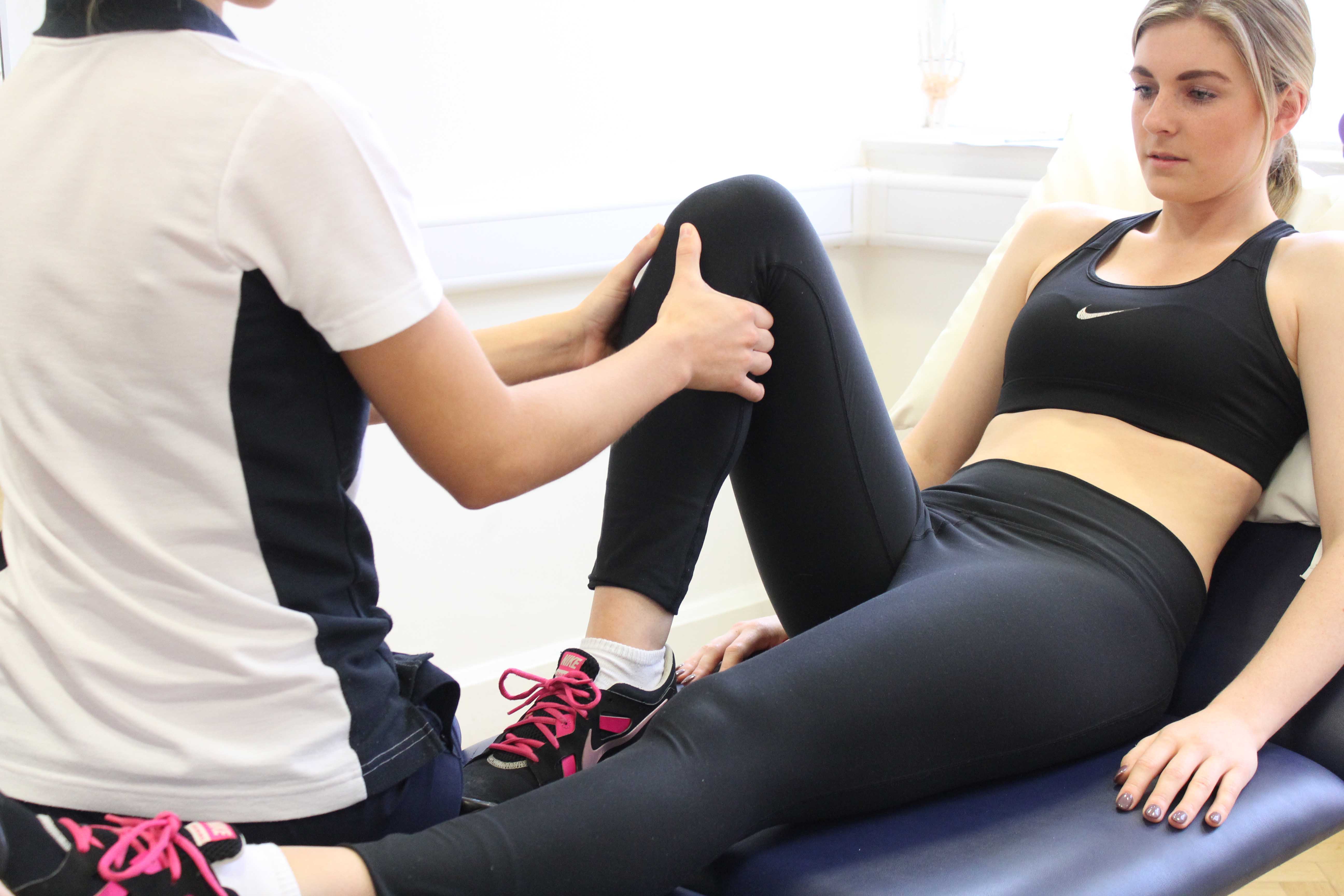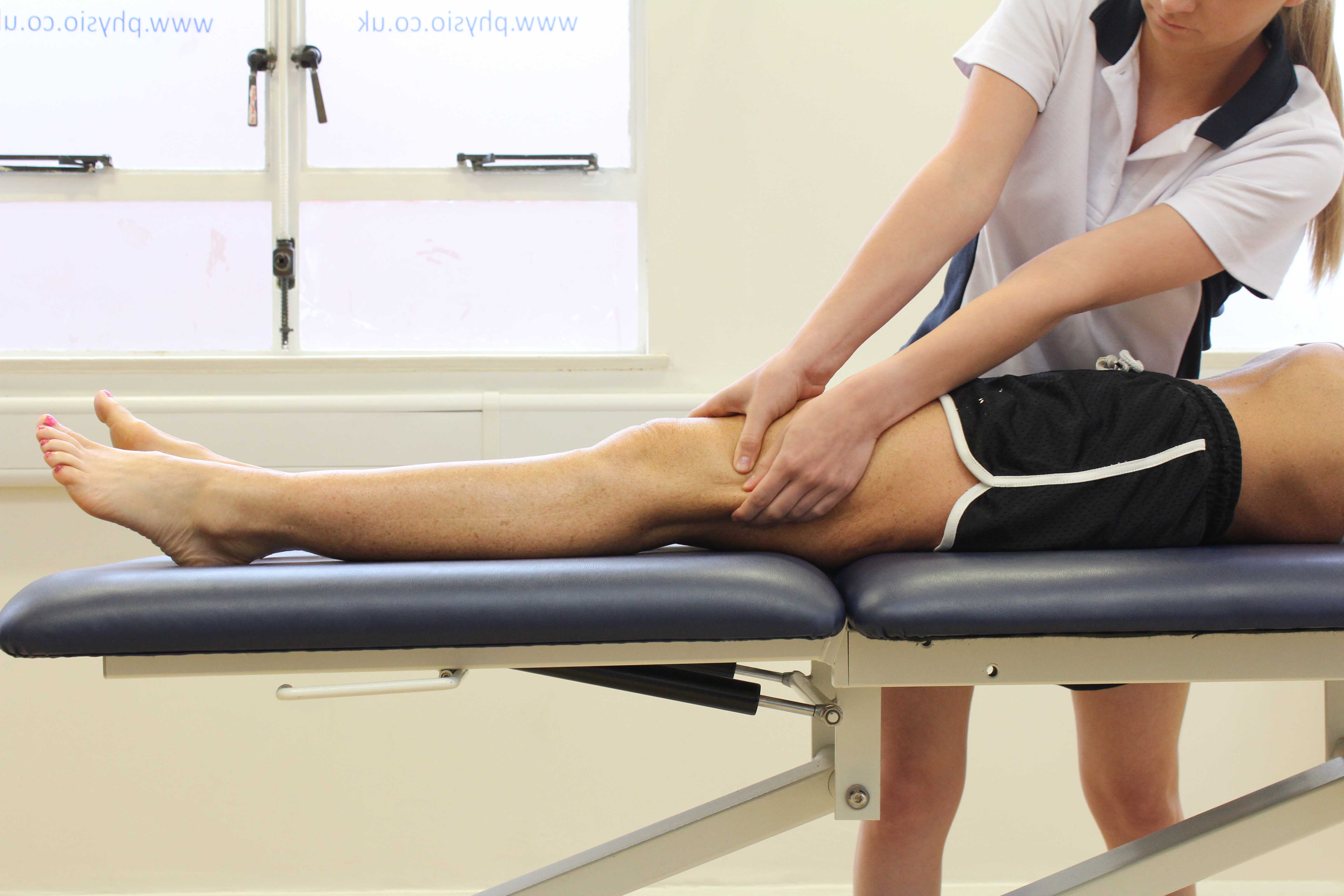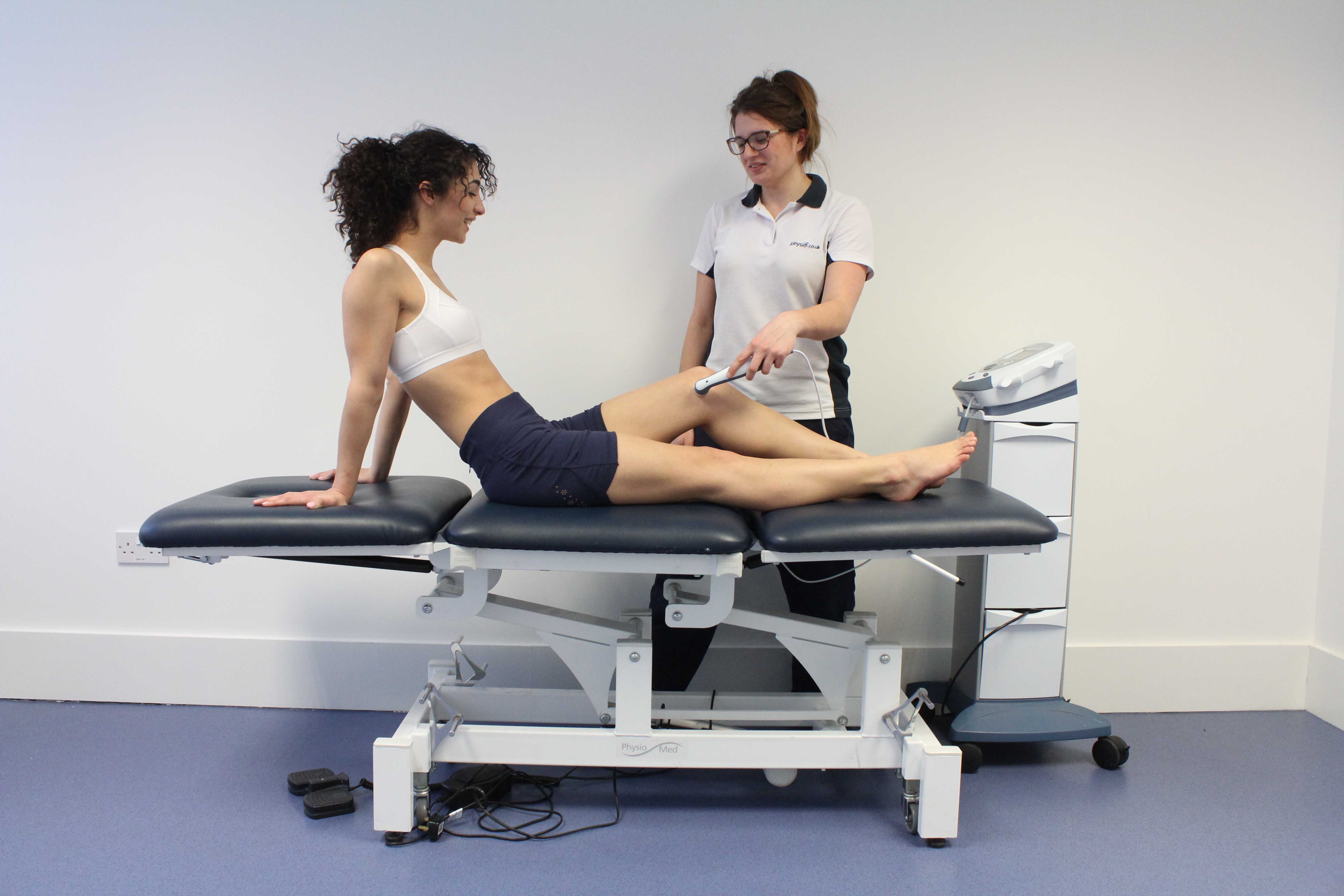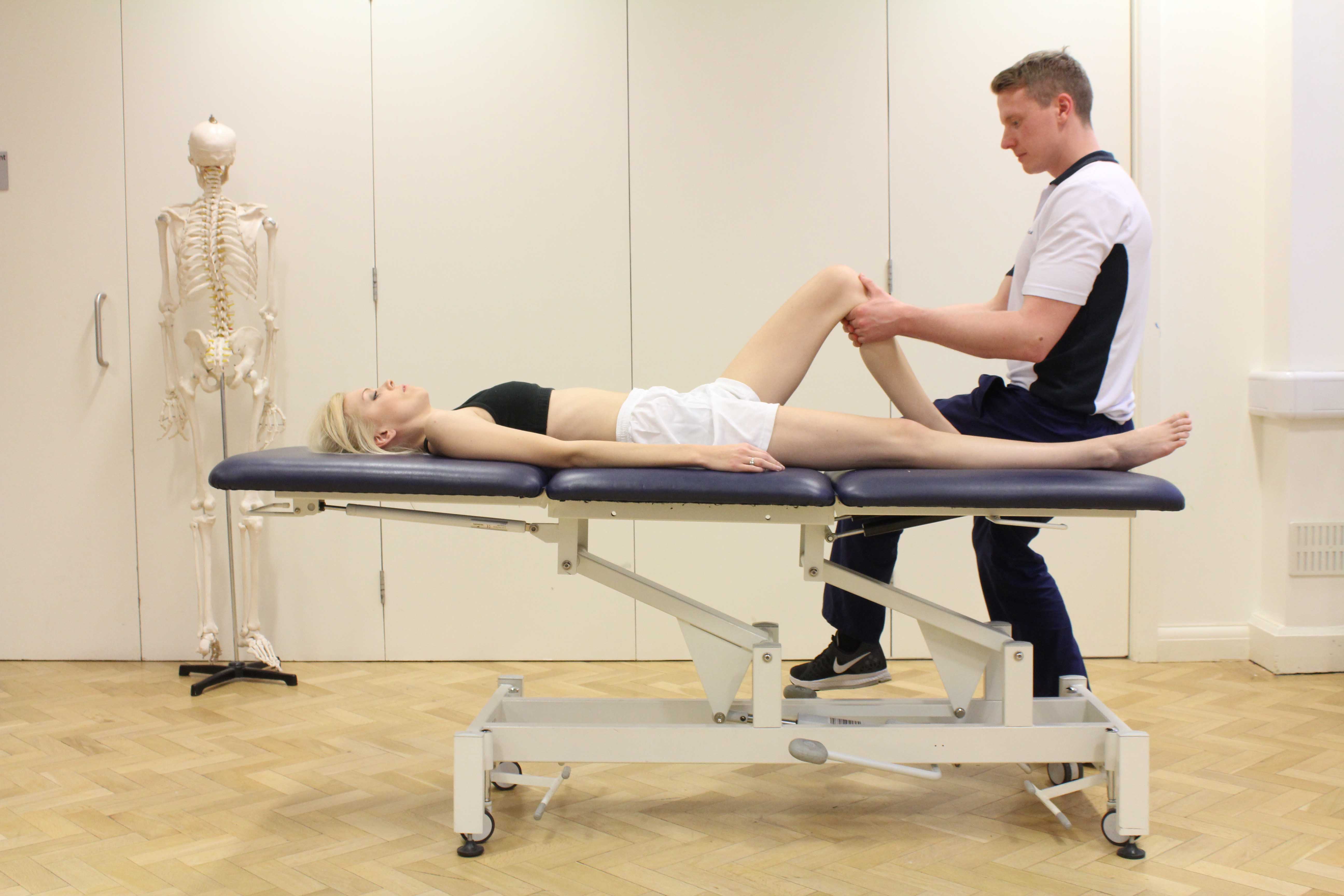Knee Arthrodesis /Fusion Surgery
Knee fusion also known as knee arthrodesis is a surgical procedure that involves joining together (fusion) the thigh bone with the shin bone. Physiotherapy plays an important role in rehabilitation and recovery following knee fusion surgery.
 Above: Mobilisations of the knee joint by a MSK therapist
Above: Mobilisations of the knee joint by a MSK therapistKnee arthrodesis is rare but is highly recommended for conditions that have caused a considerable amount of irreversible damage to the knee joint to preserve as much function as possible. Knee arthrodesis is performed for a variety of reasons including:
- Failed total knee replacement
- Infection
- Tumour
- Trauma
- Osteoarthritis and other severe degenerative diseases of the knee
Alternative to Total Knee Replacement
Surgical knee fusion may be recommended as an alternative to total knee replacement when total knee replacement has failed and is causing severe damage and deformity within the knee joint. In the situation where total knee replacement has failed or when total knee replacement is inappropriate due to severe damage to the knee, knee fusion will help eliminate pain, instability and prevent infection within the knee joint.
 Above: Soft tissue massage of the muscle and connective tissues around the knee
Above: Soft tissue massage of the muscle and connective tissues around the kneeInfection
In addition to total knee replacement failure, infection within the knee joint is another common indication for undergoing knee arthrodesis. Infections in the knee joint are mainly caused by open wounds that have become septic often as a result of a previous surgical procedure on the knee joint. Severe infections can cause considerable damage, pain and reduced function within the knee joint. Knee fusion is recommended to help eliminate infection and pain and increase joint stability.
Tumours
One of the most common sites for bone tumours occur within the knee joint. Bone tumours in the knee can cause significant pain, expansion into local structures, joint dysfunction, bone weakness, bone cell death and fractures. During knee fusion, tumours at the bottom of the thigh bone (femur) and at the top of the shin bone (tibia) are often removed and the remaining ends of the bones are then fused together to preserve as much function in the joint as possible. With more serious tumours that have spread further, amputation is the more likely procedure.
 Above: Ultrsound eletrotherapy applied to the soft tissues of the knee by Physiotherapist
Above: Ultrsound eletrotherapy applied to the soft tissues of the knee by PhysiotherapistTrauma
In the incidence of severe trauma which has caused irreversible damage to the knee joint, knee fusion is recommended when total knee replacement would no longer be effective and as a more functional alternative to amputation.
Osteoarthritis
Commonly, total knee replacement is the appropriate treatment for severe osteoarthritis of the knee. In some cases, knee fusion may be more suitable when osteoarthritis and other forms of degenerative diseases (rheumatoid, tuberculous or inflammatory arthritis) has caused considerable amount of damage within the knee followed by severe pain, instability, deformity and a significant decrease in function. Knee fusion would offer a rigid but painless, stable and problem free knee.
 Above: Mobilisations of the knee joint by a MSK therapist
Above: Mobilisations of the knee joint by a MSK therapistSurgical Procedure
During knee fusion the bony ends of the femur and tibia are cut off, together with ligaments, menisci and the synovial joint lining is stripped out. After which, the end of the thigh bone (femur) and the end of the shin bone are encouraged to fuse with one another using screws and plates to compress and hold the bones together. Surgical techniques used include:
- Intramedullary Nailing : IM nails / rods are inserted into the bone marrow canal in the center of the thigh bone (femur) and are continued along to the shin bone (tibia) in order to hold the bones together to encourage fusion of the knee joint
- External Fixation: use of external rods and screws that originate from the outside of the joint and insert into the joint to compress and hold the bones in place
- Internal Fixation: use of internal rods and screws that are placed on the inside of the joint to compress and hold the bones in place
- Plates: a number of plates placed inside the joint on the inner side and outer side of the knee with obtruding screws that compress and hold the bones in place
Knee fusion surgery is fairly rare but is recommended when there has been irreversible damage to the knee joint to provide a pain free, stable and somewhat functional limb. Success of knee fusion depends on the adequacy of bone stock and how well the bones are compressed and held together by the internal or external screws, pins or plates.
Physiotherapy is vital after knee fusion surgery to guarantee the success of the surgery, prevent the likelihood of problems occurring in the future and to help the patient adjust appropriately to their newly fused knee.
Symptoms after knee fusion surgery
After you have undergone knee fusion you will experience pain and swelling around the fused knee joint as a result of the surgical technique used. Your leg will be rigid and you will be unable to bend your knee. Your leg will be elevated to maintain circulation and reduce any swelling. Your leg will be supported and immobilised with a long leg cast which also provides essential protection. After a number of days you will able to get up and about and you will be provided with elbow crutches. Your hospital stay may last from 1 to 2 weeks or longer if necessary depending on your recovery. You will be wearing the long leg cast and be non weight bearing for up to 12 weeks after your discharge. This is so that your knee joint has adequate time to fuse together and subsequently heal. After 12 weeks, your long leg cast will be removed and you will be provided with a knee brace. You will now be encouraged to partially weight bear on the affected leg before gradually progressing to full weight bearing. You may be unable to drive after knee fusion surgery. Physiotherapy will start immediately after your knee fusion surgery but you will be able to partake in a full and comprehensive physiotherapy programme once your knee joint has fully fused and healed which should be after 12 weeks.
Physiotherapy after knee fusion surgery
Physiotherapy is crucial after knee fusion surgery to help you become accustomed and familiar with your newly fused knee. A comprehensive physiotherapy programme with Physio.co.uk will give you essential support and help you adjust effectively. Your physiotherapy programme will primarily aim to strengthen the muscles around the affected knee, hip, ankle and leg to allow the leg to function as effectively as possible after your knee fusion surgery.
Early stages (1-12)
In the early stages after your knee fusion your physiotherapy will aim to reduce your pain and swelling and prevent the likelihood of any problems occurring as a result of the surgery. At this stage you will still be wearing a long leg cast to ensure sufficient fusing and healing of your knee joint therefore physiotherapy will be limited. Physio.co.uk will provide you with exercises that focus on strengthening the muscles in and around your hip, ankle and opposite leg for vital support whilst your leg remains in the long leg cast and after it has been removed. Physiotherapy at this time will encourage you to keep as mobile as possible to maintain a good circulation in your affected leg and elsewhere. An adequate blood flow will help guarantee the prevention of complications such deep vein thrombosis, infection and bone cell death. Your physiotherapy at this stage will include:
- Modalities to control pain and swelling
- Elbow crutch training
- Non weight bearing exercises
- Strengthening exercises for muscles in unaffected leg (quadriceps, hamstrings, calf muscles)
- Ankle exercises in affected leg
- Functional, non weight bearing activities using elbow crutches (climbing stairs, sit to stand, moving certain distances etc)
3-6 months
Once your knee had fused and healed adequately, your long cast will be removed and you will be provided with a knee brace for continued support and protection.At this time your physiotherapy programme with Physio.co.uk will aim to progress your weight bearing ability from non weight bearing to partial weight bearing and eventually to full weight bearing as tolerated by you. Physio.co.uk will also aim to strengthen the muscles around your affected knee, hip, ankle and continue to strengthen your unaffected leg. Additionally, other important goals at this stage include, gait re education and proprioception (balance) training to maximise your functional capabilities and to ensure that you are adjusting as much as possible to having a fused knee. Your physiotherapy with Physio.co.uk will offer support, advice and continue to help you adjust to your newly fused knee. Your physiotherapy will include:
- Partial to full weight bearing exercises as tolerated
- Strengthening of muscles in hip, knee and ankle in affected leg (quadriceps, hamstrings, hip flexors, glutes and calf muscles)
- Strengthening of muscles in hip, knee and ankle in unaffected leg (quadriceps, hamstrings, hip flexors, glutes and calf muscles)
- Strengthening exercises for core and back muscles
- Stretching of quadriceps, hamstrings, hip flexor, and calf muscles in both legs
- Range of movement exercises in hip and ankle of affected leg
- Range of movement exercises in unaffected leg and back
- Upper limbexercises
- Gait re-education
- Proprioception ( balance) training
- Hydrotherapy
6 months onwards
After 6 months of intense physiotherapy with Physio.co.uk and to guarantee effective function in your affected limb, your physiotherapy programme will encourage the continuation of exercises from previous weeks whilst also focusing on improving cardiovascular fitness and functionally specific activities. At this stage you will be fully weight bearing and you should now be gradually becoming more and more comfortable with your fused knee. Therefore, at this point after your surgery you will be able to take part in more physically demanding activities as tolerated by you. The continued focus on gait re-education and proprioception training remains an important factor in your physiotherapy programme during this stage and in the future. Your physiotherapy will include:
- Continuation of strengthening exercises for both lower limbs, upper limbs, core muscles and back
- Continuation of range of movement exercises for both lower limbs, upper limbs, core muscles and back
- Gait re-education
- Proprioception (balance) training
- Appropriate agility (change direction) training
- Hydrotherapy
- Hobby and functional specific activities that are personal to you
Summary
Knee fusion surgery is the unavoidable surgical procedure that involves the fusion of the bottom end of the thigh bone (femur) with the top end of the shin bone (tibia) as a result of irreversible damage to the knee joint caused by failed knee replacement, infection, severe arthritis or trauma. Knee fusion is carried out by the surgeon stripping out the affected knee joint and encouraging the bony ends to fuse to one another by compressing and holding the bones together using internal / external plates, pins and screws or a combination of each. Knee fusion is a salvage procedure that can offer a painless, stable and somewhat functional limb after significant damage to the knee joint has occurred. Physiotherapy with Physio.co.uk is crucial after knee fusion surgery to ensure the success of the surgery, prevent the likelihood of complications occurring in the future, help you adjust to your newly fused knee and guarantee you a quicker and more efficient recovery after your knee fusion surgery. Physio.co.uk will offer you a comprehensive and personal physiotherapy programme that will ensure the return of a painless, stable and somewhat functional lower limb. Call Physio.co.uk now on 0330 088 7800 for more information or to book an appointment please contact us.

 0330 088 7800
0330 088 7800


































